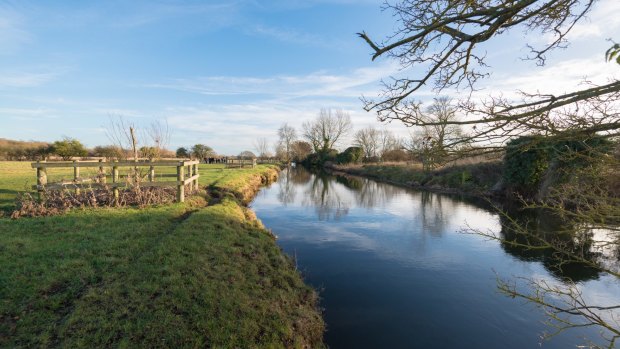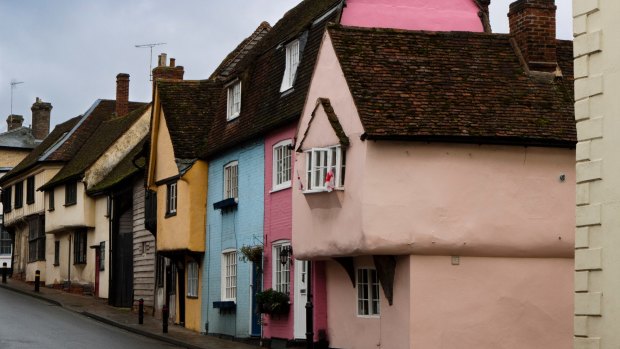This was published 4 years ago
Why Essex is well worth a side trip when visiting London
By Sue Williams

Stunning Dedham Vale landscape.Credit: Getty Images
In the worldwide competition for who's the dumbest of them all, the Essex girl is queen.
Jokes about them – well, us, since I'm originally from Essex, the UK county on the north-east outskirts of London – are legendary. "How do you make an Essex girl laugh on a Saturday?" one asks. The answer: "Tell her a joke on a Wednesday."
Of course, like all class stereotypes, the idea that Essex girls are universally dumb (not to mention outrageously wanton) is pretty stupid itself. But it has managed to draw international attention to the county, a focus exacerbated by also having spawned its own reality-TV show in The Only Way Is Essex. That, sadly, was among the first programs to get groups of over-sexed young people together, give them too much to drink, then stand back and film what happens.

Saffron Walden.Credit: Getty Images
All this does a profound disservice to what is also one of Britain's most historic, varied and fascinating regions. And, even better, it's only a 45-minute drive or train ride from the centre of London.Essex really does have everything. Want to look at where Londoners go to the seaside? Take the train to Southend-on-Sea, a gloriously down-to-earth coastal town. Among its claims to fame, Southend boasts the world's longest pleasure pier – built in 1830 and stretching an extraordinary 2.16 kilometres – and a funfair with lots of arcade machines, fairy floss, hot chips and jellied eels.
Want to visit the oldest town in the UK? Colchester, the former capital of Roman Britain, was mentioned in official dispatches as far back as 20BC. It's still a military garrison but also a lively market town, with parts of its Roman wall – built circa 65AD – still intact.
One of its main attractions is the magnificent Norman-era Colchester Castle, with construction of its keep (fortified tower) ordered by William the Conqueror. It remains the largest surviving example of a keep in Europe.
The countryside just north of the city is also some of the most stunning in England, full of picturesque villages, quaint chocolate-box cottages, dawdling rivers and the ancient shady woodlands of fairy tales. This is the landscape that inspired artist John Constable in the early 19th century, with an area on the border of Essex and Suffolk known as Constable Country.
At the centre of this idyll, Dedham Vale and the Stour Valley both have lots of walks and bicycle tracks so
the countryside can be explored, and appreciated, at leisure. There are also tours around the region, with guides showing copies of Constable's works against the actual views today. If you screw your eyes half-closed, the last two centuries just slip away.
Just 40 minutes' drive north-west of Colchester is the village of Castle Hedingham, the home – surprise, surprise – of Hedingham Castle, with the best-preserved keep in the whole of England. The castle itself – which did not survive – was built around 1100, while the keep, which still looks incredibly imposing, was constructed some 40 years later.
Another 40 minutes further west is the medieval market town of Saffron Walden, where you can stroll the cobbled streets to admire some of the oldest buildings in the country and imagine what yesteryear looked like.
It has a large parish church, St Mary's, one of the country's oldest pubs, the Old Sun Inn, and numerous historic houses. There's also the
awe-inspiring Audley End House,
a Jacobean mansion used by kings James I and Charles II. Fittingly, scenes for the award-winning drama The Crown were shot there.
At the other end of town is the Victorian-era Bridge End Garden, which has been restored to its original design and character, and which has an old hedge maze. My childhood memories of getting lost in mazes such as this never seem to fade.
But Essex is also renowned for its more recent history, and experiments in the way Brits could live. It was the location, in East Tilbury, of a model town built in the 1930s by Czech shoe manufacturer Bata for its workers – although the town only reached a third of its planned size after Bata was nationalised by Czechoslovakia's new communist regime after World War II.
Then, after the war decimated so much of London's East End, the "new town" experiment was launched. The aim was to create model, and modern, communities for relocated urban populations, and one of the best known of these is Basildon, my home town, which has just become the subject of a documentary about the idea, called New Town Utopia.
Essex combines the appeal of the old with the allure of the new. And all an easy day-trip from London.
Sue Williams travelled at her own expense.
Sign up for the Traveller Deals newsletter
Get exclusive travel deals delivered straight to your inbox. Sign up now.